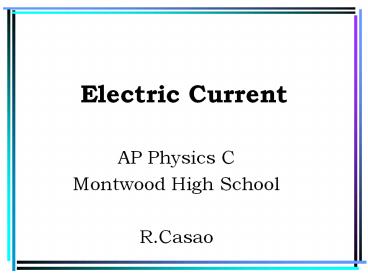Electric Current - PowerPoint PPT Presentation
1 / 22
Title:
Electric Current
Description:
Electric Current AP Physics C Montwood High School R.Casao – PowerPoint PPT presentation
Number of Views:66
Avg rating:3.0/5.0
Title: Electric Current
1
Electric Current
- AP Physics C
- Montwood High School
- R.Casao
2
The Battery
Voltas original battery
- The electric battery, invented in 1800 by Volta,
represented the basis for a wide range of
developments in electrical technology. - The wet cloth separating the plates is soaked in
a salt solution, producing a potential difference
between the two end plates.
Ag
wet cloth
Zn
electrical converter... converts chemical energy
to electrical energy
3
Electrical Description of a Battery
- A battery does work on positive charges in moving
them to higher potential (inside the battery). - The EMF (electromotive force) E is the work per
unit charge exerted to move the charges uphill
(to the terminal, inside), but you can just
think of this as an applied voltage. - Current will flow, in the external circuit
outside the battery from the terminal, to the
terminal of the battery.
4
Electromotive Force (EMF)
- Batteries, generators, and solar cells, transform
chemical, mechanical, and radiant energy,
respectively, into electric energy. These are
examples of sources of EMF. - EMF is measured in Volts V
- The source of EMF provides the energy the charge
carriers will conduct through the electric
circuit to the resistor.
5
Potential Difference or Voltage V
- Current in a circuit moves from an area of high
electric potential energy to an area of low
potential energy. This difference in electric
potential energy is necessary for current to move
through a conductor. - The positive terminal of a battery is the high
electric potential energy terminal and the
negative terminal is the low electric potential
energy terminal. - Potential difference V is also measured in volts.
6
Potential Difference or Voltage V
- Within the battery, a chemical reaction occurs
that transfers electrons from one terminal to
another. - Because of the positive and negative charges
existing on the battery terminals, a potential
difference (voltage) exists between them.
7
Potential Difference or Voltage V
- The battery creates an electric field within and
parallel to the wire, directed from the positive
toward the negative terminal. - This field exerts a force on the free electrons,
causing them to move. This movement of charge is
known as an electric current. - The current in the circuit is shown to flow from
the positive terminal to the negative terminal.
8
Potential Difference or Voltage V
- EMF is the maximum amount of energy per charge
the battery can provide to the charge carriers. - Voltage is the energy per charge the charge
carriers have after moving through the internal
resistance r of the battery. - Some of the energy added to the charge carriers
has to be used to travel through the battery. - The remaining energy is carried to the resistors
outside the battery.
9
Electric Circuits
- A simple electric circuit will consist of
- A source of energy (in this case a battery).
- Conducting wires.
- A resistor R that uses the energy.
- A switch to open/close circuit.
- The source of energy has an internal resistance r.
10
Two Types of Current
- DC current (direct current) is a steady flow of
current in one direction. - AC current (alternating current) - direction of
current flow changes many times a second. In the
US, the frequency of change is 60 Hz. Therefore,
the current changes direction 60 times per second.
11
Electric Current
- When charges of like sign move, a current exists.
- When the charges move perpendicularly to a
surface of area A, the current is the rate at
which charge flows through this surface.
12
Electric Current
- Current I
- If the current varies in time, instantaneous
current, i - Unit Ampere
- Charges flowing through a surface can be
positive, negative, or both.
13
Electric Current
- The direction of flow of positive charge is used
as the direction of the current. - In a metallic conductor, the current is due to
the motion of electrons, so the direction of the
current will the opposite to the direction of
flow of the electrons.
14
(No Transcript)
15
Drift Velocity
- The volume of a conductor of length l is V Al.
- Let n be the number of mobile charge carriers per
unit volume, then the number of charge carriers
in the volume of the conductor is nAl.
16
Drift Velocity
- The total charge in the volume of the conductor
of length l is - If the charge carriers move with speed vd, the
distance they move in time ?t is d vd ?t. Let
d l. - Current
17
Drift Velocity
- If an electric field is present in the conductor,
the electrons will start moving in a direction
opposite to the field. - The motion of the electrons will be disrupted by
frequent collisions with the ions. - The net result is that the electrons acquire a
slow average speed, or drift velocity.
18
Electron Motion in a Conductor With and Without
an Electric Field
19
Analogy of Electron Motion in a Conductor
12 Volts
0 Volts
20
Conductor with Current Moving from High
Electrical Potential (Volts) to Low Potential
21
Charges Drifting in a Conductor
- In a conductor, the electric field that drives
the free electrons travels through the conductor
with a speed close to that of light. So when you
flip a light switch, the electric field reaches
the electrons instantly.
22
Helpful Websites
- DC Circuit Water Analogy
- Air Flow Analogy































